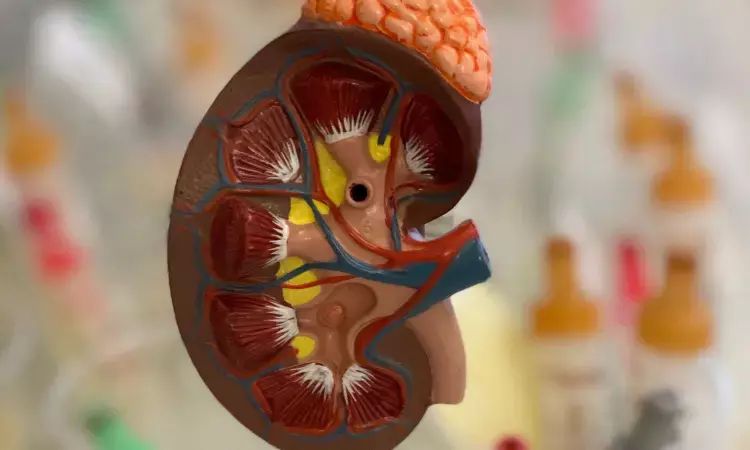- Home
- Medical news & Guidelines
- Anesthesiology
- Cardiology and CTVS
- Critical Care
- Dentistry
- Dermatology
- Diabetes and Endocrinology
- ENT
- Gastroenterology
- Medicine
- Nephrology
- Neurology
- Obstretics-Gynaecology
- Oncology
- Ophthalmology
- Orthopaedics
- Pediatrics-Neonatology
- Psychiatry
- Pulmonology
- Radiology
- Surgery
- Urology
- Laboratory Medicine
- Diet
- Nursing
- Paramedical
- Physiotherapy
- Health news
- Fact Check
- Bone Health Fact Check
- Brain Health Fact Check
- Cancer Related Fact Check
- Child Care Fact Check
- Dental and oral health fact check
- Diabetes and metabolic health fact check
- Diet and Nutrition Fact Check
- Eye and ENT Care Fact Check
- Fitness fact check
- Gut health fact check
- Heart health fact check
- Kidney health fact check
- Medical education fact check
- Men's health fact check
- Respiratory fact check
- Skin and hair care fact check
- Vaccine and Immunization fact check
- Women's health fact check
- AYUSH
- State News
- Andaman and Nicobar Islands
- Andhra Pradesh
- Arunachal Pradesh
- Assam
- Bihar
- Chandigarh
- Chattisgarh
- Dadra and Nagar Haveli
- Daman and Diu
- Delhi
- Goa
- Gujarat
- Haryana
- Himachal Pradesh
- Jammu & Kashmir
- Jharkhand
- Karnataka
- Kerala
- Ladakh
- Lakshadweep
- Madhya Pradesh
- Maharashtra
- Manipur
- Meghalaya
- Mizoram
- Nagaland
- Odisha
- Puducherry
- Punjab
- Rajasthan
- Sikkim
- Tamil Nadu
- Telangana
- Tripura
- Uttar Pradesh
- Uttrakhand
- West Bengal
- Medical Education
- Industry
Mycophenolate mofetil-based regimen as effective as conventional steroids therapy in immunoglobulin A nephropathy

Immunoglobulin A nephropathy (IgAN) is the most prevalent type of primary glomerulonephritis. Approximately 30% of patients with IgAN will develop end-stage renal disease within 10 to 30 years. Proteinuria is a key indicator of poor prognosis.
In a single-centre study on IgAN patients with active lesions, significant urinary abnormalities, and an increased risk of complications ( glucocorticosteroid-related), a mycophenolate mofetil-based regimen showed comparable outcomes in complete responses and relapse rates at 1 and 5 years compared to a conventional glucocorticosteroid-based protocol, while significantly reducing glucocorticosteroid cumulative doses. This study is published in the Journal of Nephrology.
The effectiveness and safety of a combination of mycophenolate mofetil and a short course of glucocorticosteroids for patients with histologically active immunoglobulin A nephropathy need further investigation. In the present study, a team of researchers compared the efficacy and safety of this combination therapy to conventional glucocorticosteroid therapy in patients with active lesions and major urinary abnormalities.
Thirty patients had IgA nephropathy with active histological lesions. Fifteen patients were treated with both mycophenolate mofetil 2 g/day for six months and 3 pulses of 15 mg/kg methylprednisolone. This was followed by a short tapering schedule of oral prednisone.
The control group had 15 patients treated with glucocorticosteroids alone, 1 g of methylprednisolone given intravenously for three consecutive days, followed by oral prednisone 0.5 mg/kg every other day for six months. All patients had urinary protein excretion > 1 g/24 h and microscopic hematuria at diagnosis.
Key findings from this study are:
- At the end of the first year of follow-up of 30 patients and after five years of follow-up of 17 patients, no difference was reported between the two groups related to urinary abnormalities and functional parameters.
- Both regimens achieved a significant reduction in 24-hour urinary protein excretion and a reduction of microscopic hematuria.
- Mycophenolate mofetil-based regimen allowed a cumulative sparing dose of 6 g of glucocorticosteroids.
Study limitations include the absence of randomization, the retrospective nature, heterogeneity in follow-up duration and small sample size.
The strength of the study includes patient selection. The therapy targeted active lesions and excluded patients with chronic lesions which could obscure the benefits of anti-inflammatory and immunosuppressive therapy.
This study found that an MMF-based regimen was as effective as steroids recommended by KDIGO guidelines for IgAN patients with active lesions. It also showed substantial steroid-sparing effects, suggesting an alternative strategy for reducing steroid-related morbidity in patients with metabolic syndrome, diabetes risk, or severe osteoporosis. Benefits were confirmed at five years of follow-up.
Reference:
Roccatello, D., Careddu, A., Ferro, M. et al. The steroid-sparing effects of a mycophenolate mofetil-based regimen in the management of immunoglobulin A nephropathy in patients with histologically active lesions: A comparison with a control cohort receiving conventional therapy. J Nephrol 36, 2223–2231 (2023). https://doi.org/10.1007/s40620-023-01636-6
BDS, MDS in Periodontics and Implantology
Dr. Aditi Yadav is a BDS, MDS in Periodontics and Implantology. She has a clinical experience of 5 years as a laser dental surgeon. She also has a Diploma in clinical research and pharmacovigilance and is a Certified data scientist. She is currently working as a content developer in e-health services. Dr. Yadav has a keen interest in Medical Journalism and is actively involved in Medical Research writing.
Dr Kamal Kant Kohli-MBBS, DTCD- a chest specialist with more than 30 years of practice and a flair for writing clinical articles, Dr Kamal Kant Kohli joined Medical Dialogues as a Chief Editor of Medical News. Besides writing articles, as an editor, he proofreads and verifies all the medical content published on Medical Dialogues including those coming from journals, studies,medical conferences,guidelines etc. Email: drkohli@medicaldialogues.in. Contact no. 011-43720751


